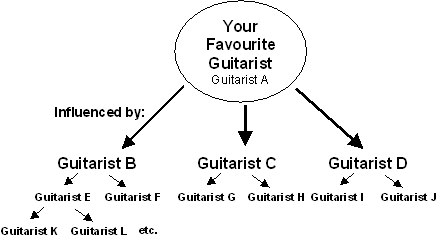It’s time to take the Circle of Influence even further. In the first part of this exercise we looked at tracing your favourite guitar player’s influences back one generation.
So for example, if your favourite guitarist is guitar player A, you find out who guitar player A’s influences were. Next, listen to and learn how to play songs written by those influences.
Now let’s take this even further…
Let’s say your favourite guitarist was influenced by guitar player “B”. After you have listened to guitar player B, find out who B’s influences were. Let’s say guitar player B was influenced by guitar players E and F.
Now look for recordings of these artists and listen to and analyze their work.
Who were guitarists E and F influenced by? Continue this process and trace the circle of influence back as far as you can.
As you do this you will probably find some overlapping influences. For example, a lot of contemporary guitar players have been influenced by Jimi Hendrix, Jimmy Page, Eddie Van Halen, Randy Rhoads, Ritchie Blackmore, Stevie Ray Vaughan, Chet Atkins…
I could go on, but I’m sure you get the idea.
Next, look for different bands, or guitarists that were influenced by guitar player B and listen to their music. See how they were influenced by guitar player B. What is similar and what’s different? Is the influence strong or hard to hear?
Now locate their influences.
Trace their influences back further and further.
In addition to listening to all this great music, you should also learn to play some of these songs as well.
When you do this exercise you will hear that a lot the same compositional techniques are shared between artists. Even the most original and unique guitarists where influenced by musicians that came before them. Sometimes you can easily hear these influences other times the influence may be very subtle.
If you are an aspiring composer or song writer, you can take this musical influence listening exercise even deeper.
Pick up a copy of a good music history book. Preferably find one that has recordings of the musical examples contained in the book. I would highly recommend making the investment in the books and CDs—this way you can take notes and mark up the book anyway you like and listen to the audio anytime you want.
Work your way through a music history book and listen to the recordings. Listen to the music and also listen for similarities and differences as you move through musical styles and time.
You don’t have to read through all of the details of the composers’ lives, although this can often be quite educational and entertaining, just focus on the music and what is integral to the style of the music.
You should also do this for music of the 20th century.
Learn about the history of jazz, blues, country, rock, folk, etc. As you do this, start to listen for commonalities and differences across styles.
What chord progressions are favoured in each style? How does this change over the years? What scales are used? What meters are used? What characteristics are shared across styles?
The next thing to look at is music from different cultures. Repeat this process with styles of music from different cultures and historical periods.
As you can now see, this is a big listening exercise. You could easily spend a couple of months on this or even several years! It’s up to you how far you want to take it.
As you listen to all of these different styles of music you will discover that each style of music has its own unique set of aesthetics. Some styles may share a significant group of aesthetics, while others will share little or none.
This means that for you to understand and appreciate each style of music you will need to develop a different set of ears to hear within each style.
A great way to do this is learn some music theory. With guitar music theory you will understand the building blocks of music. When you understand how music works, you make it much easier for your ears to understand what is going on in a piece of music. Think of it like this—if you don’t know what a G7b9 chord is do you think your ears will?
Guitar Music Theory it’s easier than you think! Here’s a quick and easy way to learn the basics of guitar music theory -> guitar theory.



